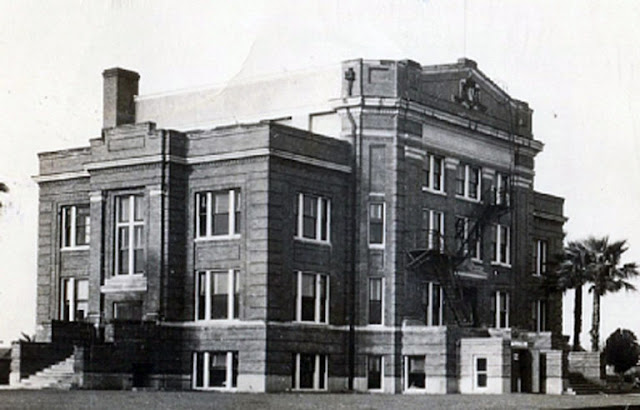Over the years Duval Courthouse hosted many judicial, political and social events
The Duval County Courthouse is, of course, primarily a judicial building. Many important cases have been heard and decided at the courthouse, some by important figures in Texas history. The courthouse is also a political structure where many public policy decisions have been made, elections have been held and eventful political actions have been hatched.
The current Duval County Courthouse, as was the case with the previous courthouses, has also been the scene of many notable cases and political events. Among the more notable visitors included Congressman Lyndon Baines Johnson, later president of the United States. The courthouse was frequently visited by Texas Rangers, Texas Attorney Generals, U.S. Attorneys, and FBI investigators.
Like most public buildings in small towns, the Duval County Courthouse has been the center of the community’s social, civic and cultural life. Following is a chronological listing of some of the more notable events that have taken place in the courthouse of Duval County, including the present structure.
In June 1879, the first district court session was held in Duval County. South Texas political kingpin Judge James B. Wells was a frequent trial attorney at the courthouse. In August 1889, his fellow attorneys voted him as acting judge when the presiding judge took ill. District Judge Stanley Welch served as judge at the Duval County Courthouse for several years before he was murdered in his sleep in Rio Grande City. Many other frontier attorneys who shaped South Texas history were frequent litigators at the courthouse.
James O. Luby, often referred to as Mr. Republican of South Texas served as the first County Judge and helped shape the county’s early history.
 |
| John Williamson Moses, mustanger, politician, writer. |
Another early county judge was John Williamson Moses, a mustanger, lawyer, writer, rugged frontiersman. State Senator and State representative N. G. Collins, who played a large role in the development of the area, was a frequent presence at the Duval County Courthouse, as was Sheriff John Buckley, grandfather of William F. Buckley, founder of the modern American Conservative movement in America.
The Corpus Christi Caller reported, in its April 4, 1883 edition, that the courthouse was undergoing metamorphosis as it was converted for theatre use of an amateur thespian troupe, which was to perform for the benefit of a local church. The thespians, who hailed from San Diego, gave a performance at the courthouse on “The Poor of Mexico,” with Señor Salvador de la Vega and his daughter in the lead roles. An encore performance was given to a smaller crowd.
On February 22, 1886, the San Diego Gun Club held a grand calico ball at the courthouse on Washington’s Birthday. “Most brilliant ball ever witnessed in this county,” the newspaper’s correspondent reported. More than 500 were present, most attired in the various cosmopolitan costumes. The courthouse was decorated with “mottoes, flowers and evergreens.”
On November 19, 1887, Professor Farquhar gave two lectures on psychology at the courthouse.
Social gatherings were not the only gatherings at the Courthouse. In February 1885, citizens gathered at the courthouse to draft resolutions to the Texas Legislature in support of keeping the Ranger force in the county. Gov. John Ireland had disbanded Rangers.
In April 1889, a meeting was held at Courthouse to see if the town could get the Southwestern or Huntington railroad to come to San Diego from Beeville.
Jail escapes occurred frequently at the jail. On September 13, 1889 all prisoners confined in the Duval County Jail, but one, escaped. Three years later, in December 1892, a convicted killer overpowered the jailer and, along with another prisoner, made a clean escape. In September 1894, three men being held in the Duval County Jail also escaped.
Political intrigue was present in the Duval County Courthouse from its earliest days. In 1886, Democratic Party County Chairman John J. Dix called for the county convention to be held at the Courthouse on July 15. The convention broke-up and some bolted to have their own meeting at the schoolhouse. In 1888 Mexican Americans in the county organized a political party to try to take over the reins of government, predating La Raza Unida by nearly a century.
In 1911, County Commissioner—and future political boss—Archie Parr tried to move Courthouse from San Diego to Benavides. It was only the first of numerous attempts to have a courthouse in his hometown of Benavides.
To be continued…




The word presence is misspelled in your article.
Thank you
Great reading! Thank you for such a delightful historical piece!
Thank you Carmelinda. Glad you enjoyed it.